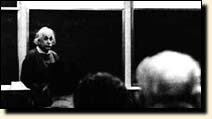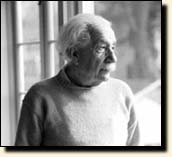
Einstein lecturing in Princeton.
|
Einstein thought that if only he could find
the right unified field theory, that theory might also explain
the structure of matter. Thus he could fill the troubling gap
in quantum theory -- the inability to describe the world otherwise
than in terms of mere probabilities. He doubted his ability
to find this "more complete theory," but he was convinced that
someday, somebody would find it. "I cannot," he admitted, "base
this conviction on logical reasons -- my only witness is the
pricking of my little finger." |

| Over the years Einstein proposed
unified field theories in various mathematical forms. Flaws
were detected in his theories one by one, usually by Einstein
himself. Undiscouraged, he would try new formulations, only
to see them fail in turn. Sooner or later most of the other
scientists who had joined the search gave it up. Einstein kept
on, aware that many of his colleagues thought he was pursuing
a will-o'-the wisp. One young physicist described him as a luminary
shining in helpless isolation. Einstein knew better than anyone
the limitations of his efforts, but the relentless work held
a "fascinating magic" for him. "One cannot help but be in awe
when one contemplates the mysteries of eternity, of life, of
the marvelous structure of reality," he wrote. "It is enough
if one tries merely to comprehend a little of this mystery each
day." With this credo Einstein had already given humanity a
new view of the physical universe, and a model for what a person
of conscience may achieve. |

"Never lose a holy curiosity."
|

"The essential in the existence of a man
like me is what he thinks and how he thinks, not what he
does or suffers." |
|
|
|
